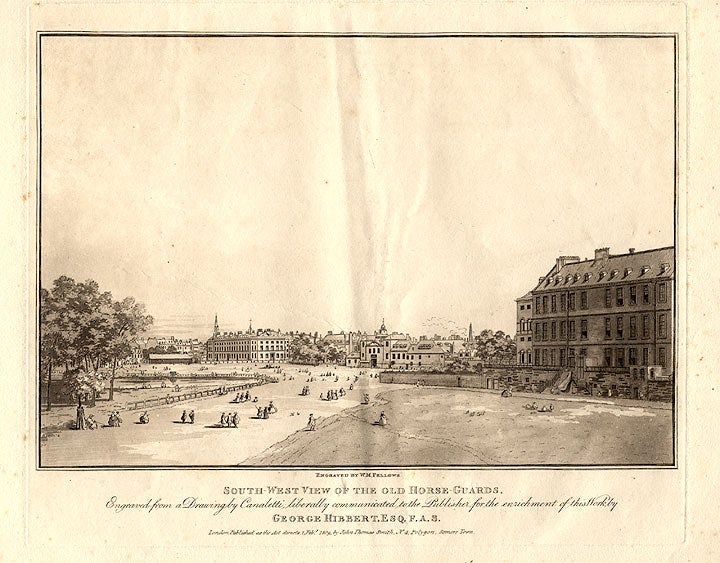FELLOWS, W.M. after Giovanni Antonio Canal, il CANALETTO (1697-1768)
South-West View of the Old Horse Guards
London: Published by John Thomas Smith, 1809. Engraving by Fellows after a drawing of 1749 in the collection of George Hibbert by the renowned Italian topographical painter, etcher and draughtsman Canaletto. Very good condition apart from some minor foxing, a light waterstain in the top margin, and a skillfully repaired 2 1/8" tear in the top left margin. Barely visible, mild crease extending through the center of the image. Sheet size: 12 1/4 x 14 7/8 inches. Plate mark: 9 1/2 x 11 1/2 inches.
A beautifully rendered view of the Horse Guards as seen from Whitehall, from Smith's "Antiquities of Westminster." Constructed in 1745 to accommodate the old palace guards, the Horse Guards Parade was and remains today one of London's largest open public spaces. Visible at the end of the parade ground are the distinctive Horse Guard buildings, which were designed by William Kent and erected in 1755.
The series from which this plate comes was originally begun with the intention of documenting the fourteenth-century murals, sculptures, and stained glass discovered during the expansion of the House of Commons. It evolved, however, into an ambitious and detailed survey involving several artists and engravers of the various buildings of the Palace of Westminster. Comprised of numerous plates (several supplementary plates were later published in 1809) accompanied by the descriptive text of John Sidney Hawkins and Smith, Antiquities of Westminster constitutes an invaluable visual record of the appearance of the Westminster before it succumbed to the fire of 1834. John Thomas Smith, an antiquarian of high repute, was also a talented etcher. His published work focuses almost entirely on London and its environs, and he was unusual for his time in that he recorded all strata of society. A pupil of the Royal Academician Joseph Nollekens and the mezzotint engraver John Keyse Sherwin, Smith began his career as engraver and topographical draughtsman. His first publication, Antiquities of London and its Environs (1800), was followed by his magnum opus Antiquities of Westminster (1807). In 1816, Smith became the keeper of prints and drawings at the British Museum, a position he held for the duration of his life. He completed The Ancient Topography of London in 1815 and continued to publish various literary and illustrated works throughout his life, including a well-received biography of Nollekens in 1828 and Cries of London (1839).
Cf. Adams, London Illustrated 1604-1851 98; cf. Lowndes III, p. 2427; cf. Abbey, Scenery of Great Britain and Ireland 210; cf.Dictionary of National Biography.
Item #13437
Price: $275.00


